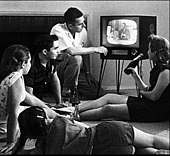
Back Liste der Fernsehsender in den Vereinigten Staaten German רשתות טלוויזיה בארצות הברית HE Lijst van televisiekanalen in de Verenigde Staten Dutch Lista de redes de televisão dos Estados Unidos Portuguese 美国无线电视网列表 Chinese
This list needs additional citations for verification. (January 2015) |
| This article is part of a US culture series on the |
| Television of the United States |
|---|
 |
In the United States, for most of the history of broadcasting, there were only three or four major commercial national terrestrial networks. From 1946 to 1956, these were ABC, CBS, NBC and DuMont (though the Paramount Television Network had some limited success during these years). From 1956 to 1986, the "Big Three" national commercial networks were ABC, CBS, and NBC (with a few limited attempts to challenge them, such as National Telefilm Associates [and its NTA Film Network] and the Overmyer Network). From 1954 to 1970, National Educational Television was the national clearinghouse for public TV programming; the Public Broadcasting Service (PBS) succeeded it in 1970.
Today, more than fifty national free-to-air networks exist. Other than the non-commercial educational (NCE) PBS, which is composed of member stations, the largest terrestrial television networks are the traditional Big Three television networks (ABC, CBS and NBC). Many other large networks exist, however, notably Fox and The CW which air original programming for two hours each night instead of three like the original "Big Three" do, as well as MyNetworkTV, which feature reruns of recent popular shows with little to no original programming, and Ion Television, which has had the same format since around 2007 but has started to pursue sports properties. Fox has just about the same household reach percentage as the Big Three, and is therefore often considered a peer to ABC, CBS, and NBC since it has also achieved equal or better ratings since the late 1990s; as of 2019, it also programs the equivalent amount of sports programming as the Big Three. Most media outlets now include Fox in what they refer to as the "Big Four" TV networks.
The transition to digital broadcasting in 2009 has allowed for television stations to offer additional programming options through digital subchannels, one or more supplementary programming streams to the station's primary channel that are achieved through multiplexing of a station's signal. A number of new commercial networks airing specialty programming such as movies, reruns of classic series and lifestyle programs have been created from companies like Weigel Broadcasting, Sinclair Broadcast Group and even owners of the major networks such as Fox Corporation (through the Fox Entertainment subsidiary), Paramount Global (through the CBS Media Ventures subsidiary), The Walt Disney Company (through the Walt Disney Television subsidiary) and Comcast (through the NBCUniversal subsidiary). Through the use of multicasting, there have also been a number of new Spanish-language and non-commercial public TV networks that have launched.
Free-to-air networks in the U.S. can be divided into five categories:
- Commercial networks – which air English-language programming to a general audience (for example, ABC, CBS, NBC, and Fox);
- Spanish-language networks – fully programmed networks which air Spanish-language programming to a primarily Latin American audience (for example, Telemundo and Univision);
- Educational and other non-commercial broadcast networks – which air English- and some foreign-language television programming, intended to be educational in nature or otherwise of a sort not found on commercial television (for example, PBS);
- Religious broadcast networks – which air religious study and other faith-based programs, and in some cases, family-oriented secular programs (for example, Daystar and TBN).
- Shopping networks – which air live presentations of various products intended to be sold directly to the viewer (for example, HSN and QVC).
Each network sends its signal to many local affiliate television stations across the country. These local stations then air the "network feed", with programs broadcast by each network being viewed by up to tens of millions of households across the country. In the case of the largest networks, the signal is sent to over 200 stations. In the case of the smallest networks, the signal may be sent to just a dozen or fewer stations.
As of the 2016–17 television season, there are an estimated 118.4 million households in the U.S. with at least one TV set.[1]
- ^ "Nielsen Estimates 118.4 Million TV Homes in the U.S. for the 2016–17 TV Season". www.nielsen.com. Archived from the original on 2019-08-06.
© MMXXIII Rich X Search. We shall prevail. All rights reserved. Rich X Search


